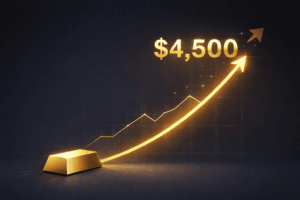Silver just surged to $41.96 — its highest level since 2010 — and according to Mike Maloney, this breakout is only the beginning. In his latest conversation with Alan Hibbard, Mike explores why precious metals are entering a new phase that could reshape everything from corporate strategy to the global monetary system.
Here are the key insights from their discussion.
The Coming Corporate Silver Rush
Silver isn’t just another commodity — it’s the backbone of modern technology. From electric vehicles to solar panels, our green future runs on silver. And Mike warns that smart companies are about to face a critical decision: lock in supplies now or risk being priced out forever.
He points to Southwest Airlines’ brilliant move in the early 2000s. While competitors were crushed by rising oil prices, Southwest thrived because they’d locked in cheap fuel contracts years earlier. Now imagine that same scenario with silver — except this time, it’s not just airlines competing. It’s Tesla, Apple, solar manufacturers, and dozens of other industries all fighting for the same limited supply.
The math is simple: industrial demand is soaring while mine supply struggles to keep pace. Companies that move first win. Those who wait? They’ll be bidding against nations.
Why Governments Are Quietly Stockpiling
Speaking of nations, here’s where things get really interesting. The U.S. recently added silver to its critical minerals list — essentially declaring it vital to national security. That single move triggered a global wake-up call.
Mike and Alan explain it perfectly: this is game theory in action. Once one major nation starts hoarding silver, others have no choice but to follow. China stockpiles? Europe responds. Europe responds? Japan jumps in. It becomes a self-fulfilling prophecy where everyone’s fear of being left behind creates the very shortage they’re trying to avoid.
The result? A feedback loop of government buying that could send prices parabolic.
The Hyperinflation Playbook (Why History Matters Now)
Mike draws a fascinating parallel to 1920s Germany that should make every investor pay attention. During World War I, Germans saved diligently while the government printed money to fund the war. Those savings sat idle, masking the true inflation brewing beneath the surface.
When the war ended and people started spending again, the dam burst. Prices didn’t just rise — they exploded. A loaf of bread that cost 1 mark eventually cost billions.
The lesson? When governments fund massive deficits through money printing, the inflation is already baked in. It’s just waiting for the right trigger. Sound familiar?
October’s Hidden Danger
Mike’s most controversial prediction might also be his most important: watch out for October. He argues that years of quantitative easing have created massive distortions in asset prices. Stock markets hit records while savers earn nothing. Real estate soars while wages stagnate.
These distortions don’t last forever. History shows they tend to unwind suddenly and violently — often in October. Whether it’s 1929, 1987, or 2008, autumn has a nasty habit of exposing market excesses.
For investors, this isn’t about panic — it’s about preparation. Traditional assets carry hidden risks that precious metals don’t.
The Bigger Story
Silver’s breakout isn’t just another price move — it’s a warning shot. When corporations and nations start competing for the same finite resource, when inflation risks mount, and when gold reasserts itself as real money, we’re witnessing a fundamental shift in the financial landscape.
The smart money isn’t asking whether precious metals will play a crucial role in the coming years. They’re asking whether they’ll be positioned before everyone else figures it out.
As Mike puts it: “The question isn’t if this happens. It’s whether you’ll be ready when it does.”
Get Gold & Silver Insights Direct to Your Inbox
Join thousands of smart investors who receive expert analysis, market updates, and exclusive deals every week.








